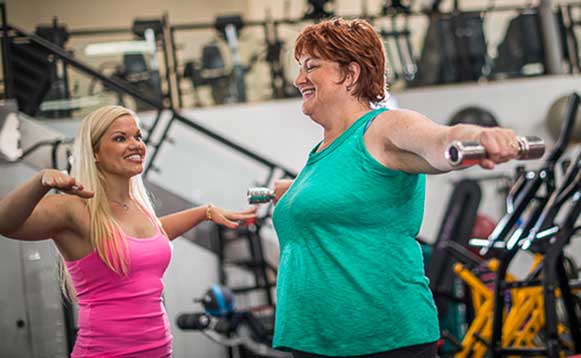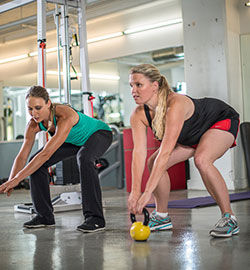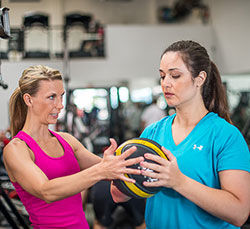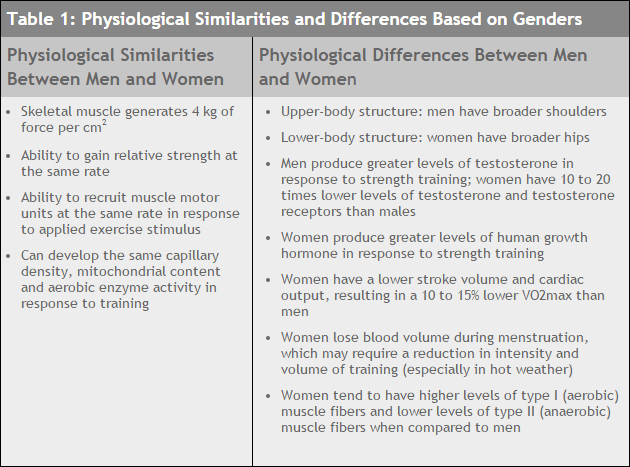
Some of life's most important messages can be found in our favorite children's stories. For example, Green Eggs and Ham by Dr. Seuss provides an important lesson for women interested in getting results from their workouts. This popular children's story is about a persistent gentleman by the name of Sam who is trying to get his friend to try the unique delicacy of green eggs and ham. After refusing to try the dish in a number of unusual places, Sam’s friend finally relents and tries the meal. And guess what? After avoiding them for so long it turns out he really likes green eggs and ham. The moral of the story is that it is important to be open to new experiences because you never know whether or not you will like something until you try it.
For many women, strength training is their green eggs and ham. It seems as if a number of female gym-goers have an unjustified fear of trying strength training as a mode of exercise, even though it can provide numerous benefits. If you've been working in fitness for more than a few minutes then you've probably heard the following from some female clients or gym members: “I want to tone up, but I don’t want to lift weights because I don't want to get big or bulky.” Or, "I want to lose weight so I'm just going to focus on cardio.”
Stepping into a free-weight area occupied by muscle-bound men may help perpetuate the perception that strength training is not appropriate for women interested in simply losing some weight or developing muscle tone, but of course nothing could be further from the truth. In fact, strength training is probably the most effective method of exercise increasing the lean muscle mass responsible for a “toned” appearance.

Busting the Gym Myths
Unfortunately, “gym myths” related to women and strength training continue to persist, despite a wealth of knowledge and research demonstrating its benefits. For example, one myth promoted by many so-called fitness experts is that a woman lifting weights will immediately break out in overly developed muscles reminiscent of the cartoonish female characters on the old American Gladiators TV game show. This is obviously not the case, as it is not possible to add a significant amount of mass in a short period of time. It’s important to note that while there are many biochemical (hormonal) differences between men and women, this article focuses on the effect that strength training has on the mechanical function of muscle and includes a review of the benefits of strength training as a mode of exercise for women.
Consider this riddle: “Which is heavier, a ton of feathers or a ton of bricks?”The answer, of course, is that they both weigh the same, but a ton of feathers takes up significantly more space than a ton of bricks. Fat mass and lean muscle have the same relationship—lean muscle tissue is denser and more compact than fat tissue. So, while 5 pounds of fat weighs exactly the same as 5 pounds of lean muscle, muscle takes up significantly less space and is more metabolically active, which means that it can burn more calories at rest than the relatively inactive fat mass. Strength training can help reduce levels of body fat and increase the amount of lean muscle. That means a woman can change the structure of her body and its ability to burn calories at rest without changing her net weight on the scale.

Due to the recent trend of high-intensity exercise and the explosive popularity of CrossFit and similar workouts that feature strength-training exercises often used in competitive formats, there has been a surge of interest in strength training among women. Artemis Scantalides, for example, used to have a full-time job as a consultant and enjoyed workouts like running and indoor cycling classes for the purpose of burning calories. “Before working in the fitness industry, my workouts were approximately 80 percent cardio and 20 percent lifting, mostly on machines.” A few years ago Scantalides made a career change and is now certified as a StrongFirst Level II and RKC Level II kettlebell instructor, co-owner of the Iron Body Studios, LLC, a kettlebell and personal training studio in Boston, Mass., and author of the IronbodybyArtemis.com blog, where she promotes the benefits of strength training to other women. A former ballet dancer, Scantalides credits strength training with kettlebells for giving her the self-confidence and mental toughness to be a business owner, as well as providing a lean, strong body that years of dance and traditional cardio training never delivered.
It can take a woman months or years of proper training, meal preparation and supplementation to develop the sculpted physique seen on muscle-bound females in popular media. Whether you call it weight lifting, resistance training or strength training, exercising with external resistance helps increase the amount of lean muscle tissue in a woman’s body, but it is a process that is simply not achievable in a few days or even a few weeks. For clients who express concern about looking too masculine as a result of strength training, it should be comforting to them to learn that, according to researchers Zatsiorsky and Kraemer (2006), "Without anabolic drugs there is little chance of women looking like men through strength training.”

A second common myth regarding women and strength training is that women should train differently than men. While women and men do have differences in the structure and physiological functions of their bodies, muscle functions exactly the same in both genders. In fact, the cross-sectional strength of skeletal muscle in both men and women is approximately 4 kg/cm2 (Siff and Verkoshansky, 2009; Powers and Howley, 2004). While men can develop higher levels of absolute strength (the total amount of weight lifted), when it comes to relative strength (the amount of weight lifted per unit of body mass) this difference diminishes. Due to the structure and muscle mass of the upper back and shoulder region, men can achieve higher levels of upper-body strength. However, when it comes to the lower body, women and men are closely matched in terms of relative strength (Baechle and Earle, 2008). “Women are capable of experiencing strength gains similar to those of men with the same amount of training experience. Because women show the same relative increases in strength and muscle size as men, the prescription of resistance-training programs does not differentiate between men and women, and the same recommendations in the design of weight-training regimens can be applied to both sexes” (Kraemer, Fleck and Deschenes, 2012).
A third myth is that women should focus on lower-intensity aerobic exercise for burning fat and avoid high-intensity or heavy-resistance training. Traditional gym mythology recommends that women should only do strength training with machines using slow, controlled movements or with light weights for higher repetitions to reduce perceived risk of injury. This myth likely arose due to the unfounded fear that using free weights for heavy or explosive lifts could cause injury. The reality is that most women are able to train at higher volumes and intensities than previously believed. In fact, women should train with enough intensity (weight) to stimulate adaptation in muscle, bone and connective tissue (ligaments, tendons, joint capsules, cartilage). If the intensity of strength training fails to provide a sufficient stimulus, the physiological benefits may be minimal. To gain maximal benefit from strength training, women should occasionally work at or near the repetition max for each exercise (Kraemer, Fleck and Deschenes, 2012).
Differences Between the Genders
For the most part, men and women have similar physiology. However, there are some key differences that cause women to have slightly different adaptations to strength training than men (Table 1). One difference is in the type of fibers that make up the body’s muscle tissue. While men tend to have higher concentrations of type II fibers, which are more responsive to strength training, women have higher levels of type I fibers related to aerobic efficiency. Additional differences include the amount of fat stored by the body. Due to the need to support different biological functions, such as childbirth, women naturally store more fat than men.


The primary hormones related to muscle growth are testosterone (T), human growth hormone (GH) and insulin-like growth factor (IGF-1). The metabolic and mechanical stress created by strength training initiates a repair process in which hormones help rebuild and restructure the damaged muscle proteins. T is the hormone most closely related to promoting the protein synthesis necessary to repair muscle tissue after exercise. While the muscle tissue of men and women has the same properties, one significant difference between the genders is that T is produced in the leydig cells of the testes. Women produce T in the adrenal gland, but approximately 20 times less than the amount produced by men (Kraemer, Fleck and Deschenes, 2012; Howley and Powers, 2004).
When it comes to the post-exercise endocrine response, GH and IGF-1 play a more significant role in tissue repair and muscle protein resynthesis for women. In response to strength training, “Women depend more on the pituitary secretion of GH and its variants along with growth factors to help mediate the change in muscle, bone and connective tissues” (Zatsiorsky and Kraemer, 2006). High-intensity strength training and anaerobic exercise is extremely beneficial for women because these activities promote the production of GH, which plays a role in burning fat for fuel (lipolysis) and repairing damaged muscle tissue. An additional benefit is that elevated GH levels can help promote a more youthful appearance and IGF-1 is closely linked to the production of brain-derived neurotrophic factor, a neurotransmitter responsible for helping develop new cells in the brain. Consequently, strength training will not only help women develop a leaner, sleeker appearance, it can also help sharpen their mental acuity and improve cognitive function, both of which provide numerous rewards in all types of situations.
- Ability to recruit muscle motor units at the same rate in response to applied exercise stimulus
- Men produce greater levels of testosterone in response to strength training; women have 10-to-20 times lower levels of testosterone and testosterone receptors than males
- Can develop the same capillary density, mitochondrial content and aerobic enzyme activity in response to training
- Women produce greater levels of human growth hormone in response to strength training
The Benefits of Strength Training for Women
Zatsiorsky and Kraemer (2006) identify a number of benefits of strength training for women, including:
- Improved confidence and self-esteem—not needing to ask for help to put a bag in an overhead bin on a plane, for example, can be very empowering
- Improved physical performance and function—having the ability to participate in and enjoy favorite sports or recreational activities can greatly enhance the quality of life
- Enhanced osseous (bone) structures to increase strength and reduce the risk of developing osteoporosis—this is extremely important over the course of the human aging process
- Stronger connective tissue, which increases joint stability and reduces the risk of injury
- Increased lean body mass and reduced levels of excess body fat—even though a woman may not lose any weight, her clothing sizes may decrease because muscle takes up significantly less space than adipose tissue
- Increased resting metabolic rate (RMR) due to an increase in lean muscle tissue, which can burn 5 to 7 calories per pound per day. Adding 5 pounds of lean muscle mass can increase the RMR by 25 to 35 calories per day or 175 to 245 calories per week. The more muscle added, the greater the number of calories burned while the body is at rest.
- Improved aesthetic appearance

Melissa diLeonardo, an ACE Certified Group Fitness Instructor, CrossFit coach and ReebokOne Ambassador in Chicago, credits her high-intensity powerlifting and CrossFit workouts with giving her a body that is "swimsuit ready" year round. DiLeonardo describes herself as “short and curvy” and when asked how strength training changed her body the former actress credits it with giving her a leaner lower body. “I was doing cardiovascular training, but that did not change the appearance of my butt and thighs like strength training.” In addition, diLeonardo credits her strength training workouts with giving her an improved ability to handle stress, eradicating her low-back pain and eliminating her need to take medication to address what had been a chronic health issue.
While improving aesthetic appearance is a strong motivator for starting any exercise program, developing muscle and becoming stronger can help a woman not only look better, but also experience a level of empowerment that comes from being more self-sufficient. Both Scantalides and diLeonardo credit strength training with providing them with a level of self-confidence they had never achieved on a piece of cardio equipment. For example, Artemis is a proponent of pull-ups for women and has seen first-hand how her female clients have changed both physically and psychologically by being able to do their first pull-up.
Adding Strength Training to Your Clients’ Programs
If you have female clients who want to experience the life-changing benefits that strength-training can provide, start them out with a basic free-weight barbell program. Designing a program specific for female clients is irrelevant because “the physiological characteristics of muscle in the sexes are the same, [therefore] there is no sensible reason why resistance training programs for women need to be different from those for men” (Baechle and Earle, 2008). And, as authors Kraemer, Fleck and Deschenes (2012) note, "When presented with the same exercise stimulus with respect to intensity, frequency and duration, men and women undergo similar improvements.”
When asked about her regular workout routine, diLeonardo stated that she does CrossFit workouts two to three times a week, and when she can't make it in for a workout of the day she does her own strength-training workouts, mixing duration and intensity. In addition to strength training, she makes time to run, dance and cycle at least once per week, as well as teach and practice of yoga. "While I love strength training, yoga is important to help with the process of recovery and I love it for the sense of relaxation it provides," says diLeonardo.
For her workouts, Scantalides does heavy kettlebell training at least three days per week, light strength training or bodyweight-strength training two days a week. She also tries to make time to practice yoga and kung fu. When asked why women should add strength training to their workouts, Scantalides stated that, in all her years of being active, strength training is “the most effective method for improving health, building muscle and developing self-confidence.”
Once a client learns the mechanics of the basic lifts, increasing the amount of intensity is extremely important. Challenge your female clients to use an appropriate amount of resistance, because developing strength is directly related to the applied resistance loads. The use of higher training volumes for women is necessary to develop lean tissue mass, and multiple-set periodized training programs have been shown to be superior to single-set circuit training workouts (Zatsiorsky and Kraemer, 2006). Female fans of CrossFit-style workouts should feel good knowing that they “can benefit by incorporating various snatching and cleaning movements into their training programs because adaptations resulting from these large muscle mass, multijoint exercises transfer well to performance in recreational and sport activities” (Beachle and Earle, 2008).
Conclusion
It is often said that the definition of insanity is doing the same thing over and over, but expecting different results. If you have female clients who want to “lose weight” and “tone up,” strength training is probably the most effective mode of exercise to achieve that goal. However, many women have bought into the myths regarding strength training and women and continue doing the same aerobic exercise they have always done, even though they are not happy with the results. Personal trainers have the opportunity to encourage female clients to try strength training and, much like the character in the Dr. Seuss story, many will realize that they actually like the results they achieve from strength training.
References
Baechle, T.R. and Earle, R.W. (2008). Essentials of Strength Training and Conditioning, 3rd ed. Champaing, Ill.: Human Kinetics.
Kraemer, W., Fleck, S. and Deschenes, M. (2012). Exercise Physiology: Integrating Theory and Application. Philadelphia, Pa.: Lippincott, Williams and Wilkins.
Powers, S. and Howley, E. (2004) Exercise Physiology: Theory and Application to Fitness and Performance, 5th ed. Boston, Mass.: McGraw Hill.
Siff, M. and Verkoshansky, V. (2009). Supertraining, 6th ed. Denver, Co.: Supertraining Institute.
Zatsiorsky, V. and Kraemer, W. (2006). Science and Practice of Strength Training, 2nd ed. Champaign, Ill.: Human Kinetics.





 by
by 








